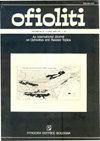希腊Othrys蛇绿岩Agios Stefanos矿铬铁矿中首次发现Ni-V-Co磷化物
IF 1.3
4区 地球科学
Q2 GEOLOGY
引用次数: 10
摘要
磷化矿物通常小于20 μm,主要由Ni-V-Co-Mo成分组成,这些成分发现于希腊Othrys蛇绿岩Agios Stefanos矿铬铁矿样品的精矿中。铬铁矿中的尖晶石富含fe2o3,与脚状铬铁矿中的铬铁矿非常相似。其Cr/(Cr+Al)比值低于具有亲合力的铬铁矿。根据磷化矿物的化学成分,确定了以下磷化矿物:镁铝辉石、磷化镍和两种相,可分为(i) Ni-allabogdanite或ni - barbarerite,和(ii) V-allabogdanite或v - barbarerite。在反射光显微镜下,所有被检测的磷化矿物显示出相似的反射率和乳黄色,尽管它们的成分不同。磷化镍则表现出弱的各向异性。ni -矽辉石或ni -矽辉石与v -矽辉石或v -矽辉石表现出较强的各向异性。它们与白钨矿、镍黄铁矿、天然钒、硫化钒、Mo-Ni-V-Co合金(可能是六钼)、硒化汞(可能是铁锰矿)和几种由Ni、As和Sb组成的矿物伴生,少数与铬铁矿、绿泥石、石英和玻璃接触。这种矿物组合表明,发现的矿物是天然的,它们不代表与样品制备有关的人工制品。结果表明,所选矿物是在局部还原地球化学环境中结晶形成的。在橄榄岩的蛇纹石化过程中,在h2o的还原过程中释放出含有溶解的h2的还原性流体,因此这些磷化物及其伴生矿物可能是在低温蛇纹石化过程中析出的。镍和钴可能是在橄榄石蚀变过程中释放出来的,或者它们原本是在岩浆硫化物中赋存的,这些硫化物在蛇纹岩化过程中被蚀变。磷可能是磷灰石和橄榄石的蚀变产物。钒可能是在宿主铬铁矿蚀变过程中释放出来的。我们推测Mo最初是在硫化物或氧化物中存在的,在其再活化后,它被纳入富Mo相的晶格中。另一种可能是,奥斯里的高还原矿物可能是由于它们的宿主岩石与闪电相互作用而形成的。磷化矿物的化学计量学分析表明,在奥色里斯铬铁矿中发现的一些颗粒可能代表新的矿物种类,如Ni-allabogdanite或ni - barbarerite,以及V-allabogdanite或v - barbarerite。然而,它们的体积小,与其他矿物的复杂微共生妨碍了x射线衍射研究的详细进行,而x射线衍射研究将明确地确定它们的性质。据我们所知,奥斯里铬铁矿中的千镍矿和磷化镍是首次在陆地样品中发现这些稀有矿物。本文章由计算机程序翻译,如有差异,请以英文原文为准。
First occurrences of Ni-V-Co phosphides in chromitite from the Agios Stefanos Mine, Othrys Ophiolite, Greece
Phosphide minerals, generally less than 20 μm in size, are mainly made of Ni-V-Co-Mo constituents, discovered in concentrates obtained from chromitite samples from the Agios Stefanos mine, Othrys ophiolite, Greece. Spinel from the chromitite is rich in Fe 2 O 3 and very similar to chromites from podiform chromitites. Its Cr/(Cr+Al) ratios are lower than those of chromites with a boninitic affinity. On the basis of their chemical compositions, the following phosphide minerals have been identified: melliniite, nickelphosphide and two phases that can be classified as (i) either Ni-allabogdanite or Ni-barringerite, and (ii) either V-allabogdanite or V-barringerite. Under reflected-light microscope, all the inspected phosphide minerals display similar reflectance and a creamy-yellowish color, despite their different compositions. Melliniite is isotropic, while nickelphosphide shows a weak anisotropism. The Ni-allabogdanite or Ni-barringerite and V-allabogdanite or V-barringerite display a strong anisotropism. They occur associated with awaruite, pentlandite, native vanadium, vanadium sulfides, Mo-Ni-V-Co alloy (probably hexamolybdenum), Hg selenide (possible tiemmanite) and several minerals composed of Ni, As and Sb. A few of them were in contact with chromite, chlorite, quartz and glass. This mineralogical assemblage suggests that the discovered minerals are natural in origin and they do not represent an artefact related to the sample preparation. Furthermore, it is suggested that the investigated minerals have been crystallized in a local reducing geochemical environment. During the serpentinization of peridotites, reducing fluids containing dissolved H 2 are released from the reduction of H 2 O. Therefore, these phosphides and the associated minerals may have precipitated during the serpentinization process at low temperature. Nickel and cobalt may have been released during alteration of olivine or they were originally hosted in magmatic sulfides that were altered during the serpentinization. Phosphorous may represent an alteration product of apatite and olivine. Vanadium was probably released during the alteration of the host chromite. We speculate that Mo was originally hosted in sulfides or oxides and after its remobilization it was incorporated into the crystal lattice of the Mo-rich phases. Alternatively, the high reducing minerals of the Othrys may have formed because of the interaction of their host rock with a lightning. The stoichiometry of the analyzed phosphide minerals indicates that some grains found in the Othrys chromitites may represent new mineral species, such as Ni-allabogdanite or Ni-barringerite, as well as V-allabogdanite or V-barringerite. However, their small size and complex micro-intergrowths with other minerals inhibit the elaboration of an X-ray diffraction study, which would unequivocally determine their nature. To the best of our knowledge, melliniite and nickelphosphide in the Othrys chromitite represent the first finding of these rare minerals in terrestrial samples.
求助全文
通过发布文献求助,成功后即可免费获取论文全文。
去求助
来源期刊

Ofioliti
地学-地质学
CiteScore
2.40
自引率
7.70%
发文量
1
期刊介绍:
Since 1976, Ofioliti provides an international forum for original contributions and reviews in the field of the geodynamics, petrology, geochemistry, biostratigraphy, stratigraphy, tectonics and paleogeography applied to ophiolitic terrains and modern oceanic lithosphere, including their sedimentary cover. Studies of topics such as geodynamics of the mantle, the evolution of orogens including ophiolites and paleoceanography are also welcome
 求助内容:
求助内容: 应助结果提醒方式:
应助结果提醒方式:


